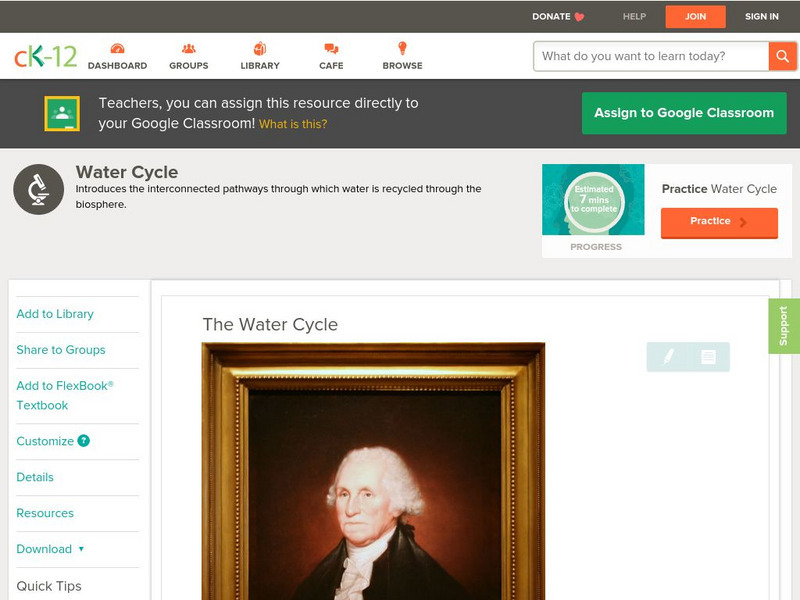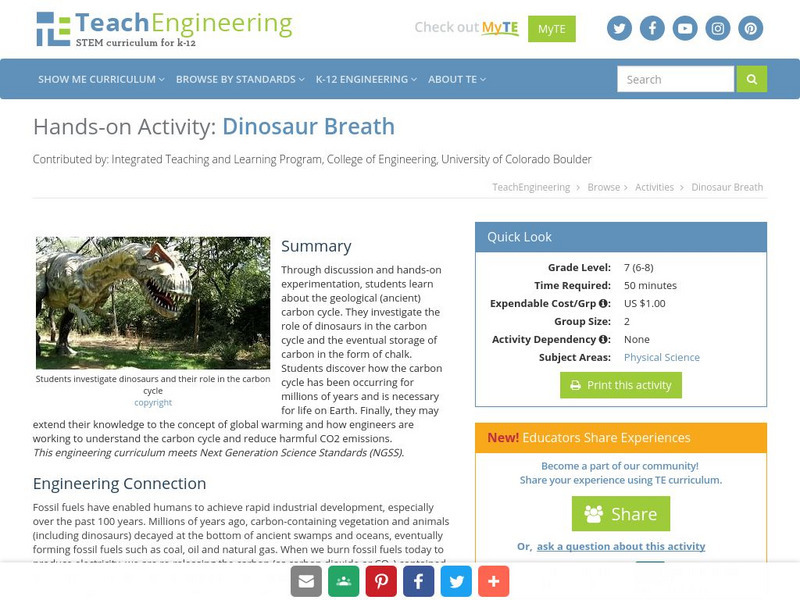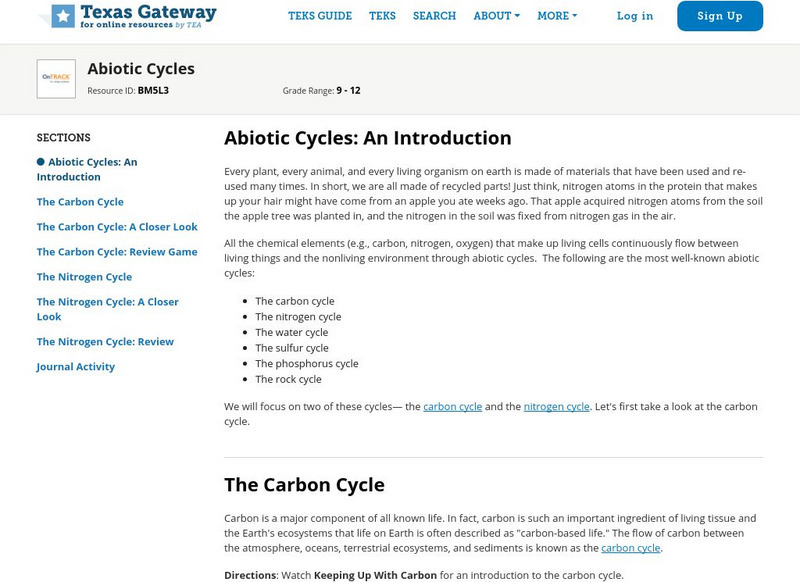Hi, what do you want to do?
National Earth Science Teachers Association
Windows to the Universe: Biogeochemical Cycles
Biogeochemical cycles happen when individual elements are recycled over and over in different parts of the Earth. Two examples are the Nitrogen Cycle and Carbon Cycle. Read an explanation of biogeochemical cycles and view a diagram of...
University Corporation for Atmospheric Research
Ucar: Project Learn: Where in the World Is Carbon Dioxide?
In this lesson on greenhouse gas, students conduct experiments to detect and collect carbon dioxide, then use titration to determine how much carbon dioxide is present in an indicator solution.
BiologyWise
Biology Wise: An Easy Explanation of the Carbon Cycle for Kids
The importance of the carbon cycle, how it works, the sources of carbon, and the steps in the carbon cycle are explained here.
BiologyWise
Biology Wise: A Brief Guide to the Steps of the Carbon Cycle
Outlines the steps for the movement of carbon along the carbon cycle through photosynthesis, food chains, being dissolved into the ocean, the decomposition of organisms, fossil fuel formation, industrial use of fossil fuels, carbon...
NASA
Nasa Earth Observatory: Mystery of the Missing Carbon
This article discusses the mystery of the one to two billion metric tons of missing carbon from the global carbon budget. Scientists do not know where between fifteen and thirty percent of the carbon released each year disappears to, but...
Annenberg Foundation
Annenberg Learner: Carbon Lab
This lab uses a robust model of the carbon cycle to give an intuitive sense for how carbon circulates through the atmosphere, biosphere, oceans, and crust.
PBS
Pbs Learning Media: The Fate of Carbon
Students examine the importance of carbon and learn about two Earth systems, the solubility pump and the biological pump, which cycle carbon from the atmosphere into the oceans and back again.
Science Buddies
Science Buddies: Swimming in Acid: Understanding Ocean Acidification
The oceans are a precious natural resource, part of Earth's carbon cycle. But what happens if the oceans absorb too much carbon dioxide? Many scientists are concerned that the increased absorption of carbon dioxide is causing them to...
Khan Academy
Khan Academy: Biogeochemical Cycles
Test your knowledge of the water cycle, carbon cycle, and nitrogen cycle.
Ducksters
Ducksters: Science for Kids: Carbon Cycle
Kids learn about the carbon cycle and how this nutrient travels through the ecosystem to sustain life on Earth.
NASA
Nasa: The Basics of Ocean Chemistry: Carbon, Circulation, and Critters
An explanation of ocean chemistry, supported by illustrations, for example, of the global carbon cycle in the 1980s and the annual carbon dioxide flux. The concentration of nutrients in the ocean is discussed for its impact on marine...
Science Education Resource Center at Carleton College
Serc: Understanding Carbon Storage in Forests
This instructional activity helps students learn about forest biomass and its role in carbon storage. Students will compare field-collected data with results produced by a forest biomass model to understand the process and challenges...
Encyclopedia of Earth
Encyclopedia of Earth: Physics & Chemistry: Carbon Dioxide
Explains what carbon dioxide is, where it is found, sources of it, and describes human activities that contribute to carbon depletion and increased levels of carbon dioxide in the atmosphere. (Updated: February 22, 2013)
Center for Innovation in Engineering and Science Education, Stevens Institute of Technology
Ciese: Carbon Imbalance: Algae to the Rescue? [Pdf]
A 95-page learning module that integrates biology, chemistry, and engineering. It includes in-class labs, virtual labs, and engineering design activities. Working with algae, students learn about and investigate how photosynthesis,...
Chem4kids
Chem4 Kids: Cycles Around You
There are many cycles occurring in all of the Earth's organisms, including the Earth itself. This brief page highlights some of those cycles, making readers aware of how many cycles there are, big and small.
CK-12 Foundation
Ck 12: Life Science: Water Cycle
[Free Registration/Login may be required to access all resource tools.] Water and elements like carbon and nitrogen are constantly being recycled through the environment. This process is called a biogeochemical cycle because it involves...
TeachEngineering
Teach Engineering: Dinosaur Breath
Through discussion and hands-on experimentation, students learn about the geological (ancient) carbon cycle. They investigate the role of dinosaurs in the carbon cycle and the eventual storage of carbon in the form of chalk. Students...
National Geographic
National Geographic: Sources, Sinks, and Feedbacks
Students will learn about how the Earth's carbon cycle works, as they examine the relationship between levels of carbon dioxide and water vapor in the atmosphere and the temperature of the ocean's surface. Includes online student...
TeachEngineering
Teach Engineering: Biorecycling: Using Nature to Make Resources From Waste
By studying key processes in the carbon cycle, such as photosynthesis, composting, and anaerobic digestion, students learn how nature and engineers biorecycle carbon.
Nature Conservancy
The Nature Conservancy: Reforestation: Impact on Climate
Deforestation is clearing Earth's forests on a massive scale. In this lesson plan, students learn the value of large-scale forest landscapes and their role in the carbon cycle.
Annenberg Foundation
Annenberg Learner: The Habitable Planet: Carbon Lab
An interactive lab simulation demonstrates the effects of increased carbon in the atmosphere and how that increase contributes to climate change. A data table for student records is available for download.
University Corporation for Atmospheric Research
Ucar: Biogeochemical Cycles
The ways in which an element or compound such as water moves between its various living and nonliving forms and locations in the biosphere is called a biogeochemical cycle. All of the atoms that are building blocks of living things are a...
Khan Academy
Khan Academy: The Calvin Cycle
Learn about the three stages of the Calvin Cycle reactions: carbon fixation, reduction, and regeneration of the starting molecule. See how the products of the light reactions, ATP and NADPH, are used to fix carbon into sugars in this cycle.
Texas Education Agency
Texas Gateway: Abiotic Cycles
Given scenarios, illustrations, or descriptions, the student will describe the flow of matter through carbon and nitrogen cycles and describe the consequences of disrupting these cycles.
Other popular searches
- Carbon Cycle Diagram
- Carbon Cycle Powerpoint
- Carbon Cycle Activities
- Nitrogen and Carbon Cycle
- Carbon Cycle Lesson Plans
- Carbon Cycle Game
- The Carbon Cycle
- Carbon Cycle Lab
- Carbon Cycle Worksheet
- Ecology Carbon Cycle
- Oxygen Carbon Dioxide Cycle
- Carbon Cycle Diagram Label







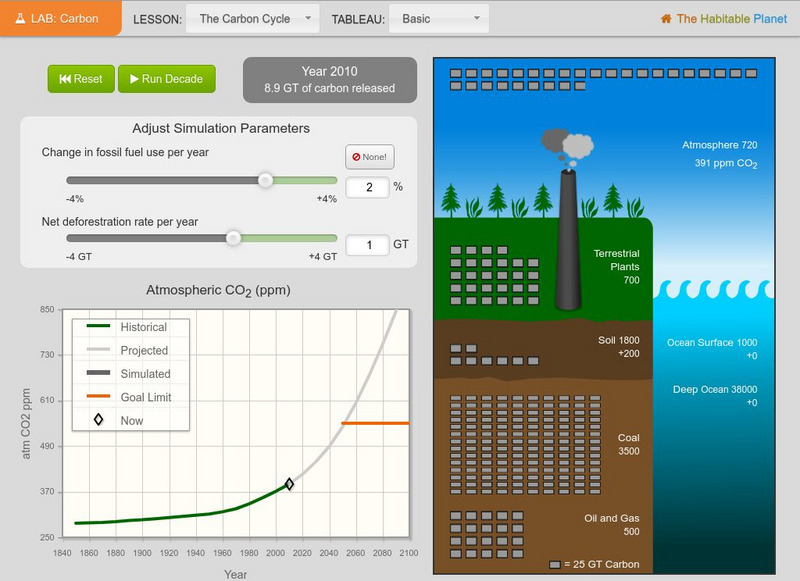



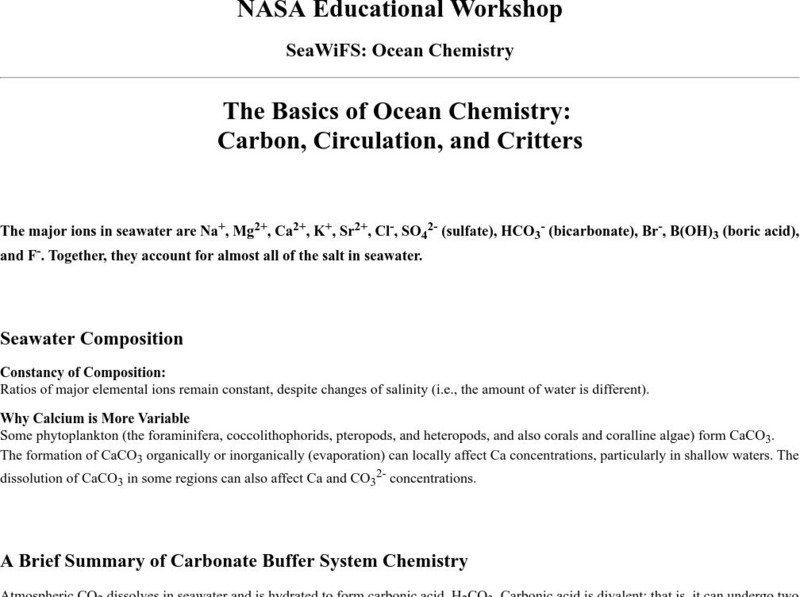

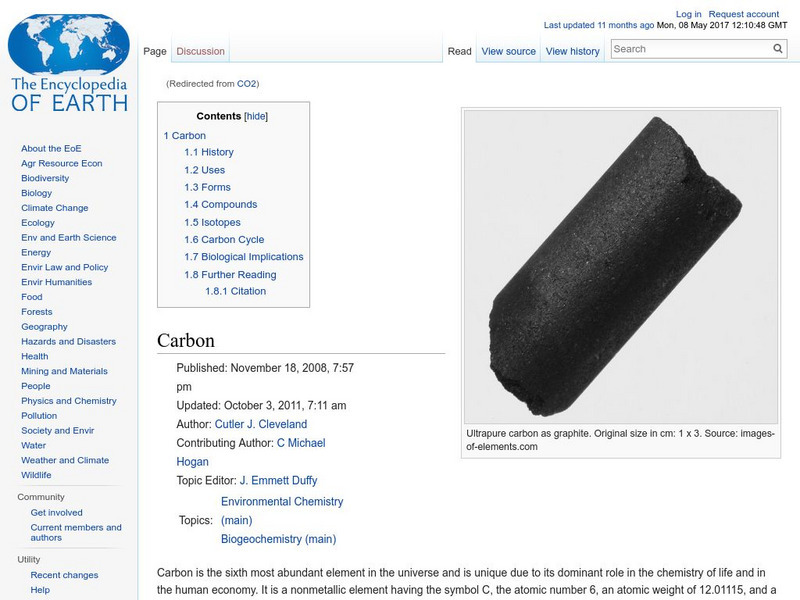
![Ciese: Carbon Imbalance: Algae to the Rescue? [Pdf] Unit Plan Ciese: Carbon Imbalance: Algae to the Rescue? [Pdf] Unit Plan](http://lessonplanet.com/content/resources/thumbnails/455842/large/bwluav9tywdpy2symdizmdeyny0xmdcynjyylwcwy3uxni5qcgc.jpg?1674855345)

